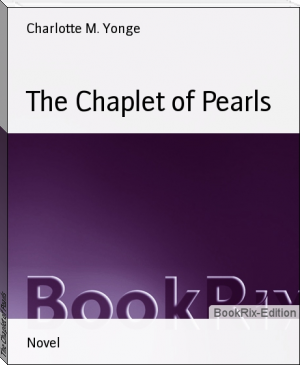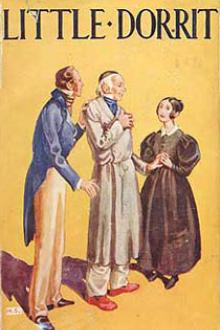The Chaplet of Pearls by Charlotte M. Yonge (best classic novels .TXT) 📕

Read free book «The Chaplet of Pearls by Charlotte M. Yonge (best classic novels .TXT) 📕» - read online or download for free at americanlibrarybooks.com
- Author: Charlotte M. Yonge
Read book online «The Chaplet of Pearls by Charlotte M. Yonge (best classic novels .TXT) 📕». Author - Charlotte M. Yonge
CONTENTS
CHAPTER I. THE BRIDAL OF THE WHITE AND BLACK
CHAPTER II. THE SEPARATION
CHAPTER III. THE FAMILY COUNCIL
CHAPTER IV. TITHONUS
CHAPTER V. THE CONVENT BIRD
CHAPTER VI. FOULLY COZENED
CHAPTER VII. THE QUEEN'S PASTORAL
CHAPTER VIII. 'LE BROUILLON'
CHAPTER IX. THE WEDDING WITH CRIMSON FAVOURS
CHAPTER X. MONSIEUR'S BALLET
CHAPTER XI. THE KING'S TRAGEDY
CHAPTER XII. THE PALACE OF SLAUGHTER
CHAPTER XIII. THE BRIDEGROOM'S ARRIVAL
CHAPTER XIV. SWEET HEART
CHAPTER XV. NOTRE-DAME DE BELLAISE
CHAPTER XVI. THE HEARTHS AND THICKETS OF THE BOCAGE
CHAPTER XVII. THE GHOSTS OF THE TEMPLARS
CHAPTER XVIII. THE MOONBEAM
CHAPTER XIX. LA RUE DES TROIS FEES
CHAPTER XX. THE ABBE
CHAPTER XXI. UNDER THE WALNUT-TREE
CHAPTER XXII. DEPARTURE
CHAPTER XXIII. THE EMPTY CRADLE
CHAPTER XXIV. THE GOOD PRIEST OF NISSARD
CHAPTER XXV. THE VELVET COACH
CHAPTER XXVI. THE CHEVALIER'S EXPIATION
CHAPTER XXVII. THE DYING KING
CHAPTER XXVIII. THE ORPHANS OF LA SABLERIE
CHAPTER XXIX. IN THE KING'S NAME
CHAPTER XXX. CAGED IN THE BLACKBIRD'S NEST
CHAPTER XXXI. THE DARK POOL OF THE FUTURE
CHAPTER XXXII. 'JAM SATIS'
CHAPTER XXXIII. THE SCANDAL OF THE SYNOD OF MONTAUBAN
CHAPTER XXXIV. MADAME LA DUCHESSE
CHAPTER XXXV. THE ITALIAN PEDLAR
CHAPTER XXXVI. SPELL AND POTION
CHAPTER XXXVII. BEATING AGAINST THE BARS
CHAPTER XXXVIII. THE ENEMY IN PRESENCE
CHAPTER XXXIX. THE PEDLAR'S PREDICTION
CHAPTER XL. THE SANDS OF OLONNE
CHAPTER XLI. OUR LADY OF HOPE
CHAPTER XLII. THE SILVER BULLET
CHAPTER XLIII. LA BAISER D'EUSTACIE
CHAPTER XLIV. THE GALIMAFRE
PREFACE
It is the fashion to call every story controversial that deals with times when controversy or a war of religion was raging; but it should be remembered that there are some which only attempt to portray human feelings as affected by the events that such warfare occasioned. 'Old Mortality' and 'Woodstock' are not controversial tales, and the 'Chaplet of Pearls' is so quite as little. It only aims at drawing certain scenes and certain characters as the convulsions of the sixteenth century may have affected them, and is, in fact, like all historical romance, the shaping of the conceptions that the imagination must necessarily form when dwelling upon the records of history. That faculty which might be called the passive fancy, and might almost be described in Portia's song,--
'It is engendered in the eyes,
By READING fed--and there it dies,'--
that faculty, I say, has learnt to feed upon character and incident, and to require that the latter should be effective and exciting. Is it not reasonable to seek for this in the days when such things were not infrequent, and did not imply exceptional wickedness or misfortune in those engaged in them? This seems to me one plea for historical novel, to which I would add the opportunity that it gives for study of the times and delineation of characters. Shakespeare's Henry IV. and Henry V., Scott's Louis XI., Manzoni's Federigo Borromeo, Bulwer's Harold, James's Philip Augustus, are all real contributions to our comprehension of the men themselves, by calling the chronicles and memoirs into action. True, the picture cannot be exact, and is sometimes distorted--nay, sometimes praiseworthy efforts at correctness in the detail take away whatever might have been lifelike in the outline. Yet, acknowledging all this, I must still plead for the tales that presumptuously deal with days gone by, as enabling the young to realize history vividly--and, what is still more desirable, requiring an effort of the mind which to read of modern days does not. The details of Millais' Inquisition or of his Huguenot may be in error in spite of all his study and diligence, but they have brought before us for ever the horrors of the _auto-da-fe_, and the patient, steadfast heroism of the man who can smile aside his wife's endeavour to make him tacitly betray his faith to save his life. Surely it is well, by pen as by picture, to go back to the past for figures that will stir the heart like these, even though the details be as incorrect as those of the revolt of Liege or of La Ferrette in 'Quentin Durward' and 'Anne of Geierstein.'
Scott, however, willfully carved history to suit the purposes of his story; and in these days we have come to feel that a story must earn a certain amount of credibility by being in keeping with established facts, even if striking events have to be sacrificed, and that the order of time must be preserved. In Shakespeare's days, or even in Scott's, it might have been possible to bring Henry III. and his _mignons_ to due punishment within the limits of a tale beginning with the Massacre of St. Bartholomew; but in 1868 the broad outlines of tragedy must be given up to keep within the bounds of historical verity.
How far this has been done, critics better read than myself must decide. I have endeavoured to speak fairly, to the best of my ability, of such classes of persons as fell in with the course of the narrative, according to such lights as the memoirs of the time afford. The Convent is scarcely a CLASS portrait, but the condition of it seems to be justified by hints in the Port Royal memoirs, respecting Maubuisson and others which Mere Angelique reformed. The intolerance of the ladies at Montauban is described in Madame Duplessis-Mornay's life; and if Berenger's education and opinions are looked on as not sufficiently alien from Roman Catholicism, a reference to Froude's 'History of Queen Elizabeth' will show both that the customs of the country clergy, and likewise that a broad distinction was made by the better informed among the French between Calvinism and Protestantism or Lutheranism, in which they included Anglicanism. The minister Gardon I do not consider as representing his class. He is a POSSIBILITY modified to serve the purposes of the story.
Into historical matters, however, I have only entered so far as my story became involved with them. And here I have to apologize for a few blunders, detected too late for alteration even in the volumes. Sir Francis Walsingham was a young rising statesman in 1572, instead of the elderly sage he is represented; his daughter Frances was a mere infant, and Sir Philip Sidney was not knighted till much later. For the rest, I have tried to show the scenes that shaped themselves before me as carefully as I could; though of course they must not be a presentiment of the times themselves, but of my notion of them.
C. M. Yonge
November 14th, 1868
THE CHAPLET OF PEARLS
or
THE WHITE AND BLACK RIBAUMONT
CHAPTER I. THE BRIDAL OF THE WHITE AND BLACK
Small was the ring, and small in truth the finger:
What then? the faith was large that dropped it down.
Aubrey De Vere, INFANT BRIDAL
Setting aside the consideration of the risk, the baby-weddings of the Middle Ages must have been very pretty sights.
So the Court of France thought the bridal of Henri Beranger Eustache de Ribaumont and of Marie Eustacie Rosalie de Rebaumont du Nid-de-Merle, when, amid the festivals that accompanied the signature of the treaty of Cateau-Cabresis, good-natured King Henri II. presided merrily at the union of the little pair, whose unite ages did not reach ten years.
There they stood under the portal of Notre-Dame, the little bridegroom in a white velvet coat, with puffed sleeves, slashed with scarlet satin, as were the short, also puffed breeches meeting his long white knitted silk stockings some way above the knee; large scarlet rosettes were in his white shoes, a scarlet knot adorned his little sword, and his velvet cap of the same colour bore a long white plume, and was encircled by a row of pearls of priceless value. They are no other than that garland of pearls which, after a night of personal combat before the walls of Calais, Edward III. of England took from his helmet and presented to Sir Eustache de Ribaumont, a knight of Picardy, bidding him say everywhere that it was a gift from the King of England to the bravest of knights.
The precious heirlooms were scarcely held with the respect due to an ornament so acquired. The manly garb for the first time assumed by his sturdy legs, and the possession of the little sword, were evidently the most interesting parts of the affair to the youthful husband, who seemed to find in them his only solace for the weary length of the ceremony. He was a fine, handsome little fellow, fair and rosy, with bright blue eyes, and hair like shining flax, unusually tall and strong-limbed for his age; and as he gave his hand to his little bride, and walked with her under a canopy up to kneel at the High Altar, for the marriage blessing and the mass, they looked like a full-grown couple seen through a diminishing-glass.
The little bride was perhaps a less beautiful child, but she had a splendid pair of black eyes, and a sweet little mouth, both set into the uncomprehending solemnity of baby gravity and contentment in fine clothes. In accordance with the vow indicated by her name of Marie, her dress was white and blue, turquoise forget-me-nots bound the little lace veil on her dark chestnut hair, the bosom of her white satin dress was sprinkled with the same azure jewel, and turquoises bordered every seam of the sweeping skirt with a train befitting a count's daughter, and meandered in gorgeous constellations round the hem. The little thing lisped her own vows forth without much notion of their sense, and indeed was sometimes prompted by her bridesmaid cousin, a pretty little girl a year older, who thrust in her assistance so glibly that the King, as well as others of the spectators, laughed, and observed that she would get herself married to the boy instead of her cousin.
There was, however, to be no doubt nor mistake about Beranger and Eustacie de Ribaumont being man and wife. Every ceremony, religious or domestic, that could render a marriage valid, was gone through with real earnestness, although with infinite gaiety, on the part of the court. Much depended on their union, and the reconcilement of the two branches of the family had long been a favourite scheme of King Henri II.
Both alike were descended from Anselme de Ribaumont, renowned in the first Crusade, and from the brave Picard who had received the pearls; but, in the miserable anarchy of Charles VI.'s reign, the elder brother had been on the Burgundian side--like most of the other nobles of Picardy--and had thus been brought into the English camp, where, regarding Henry V. as lawfully appointed to the succession, and much admiring him and his brother Nedford, he had become an ardent supporter of the English claim. He had married an English lady, and had received the grant if the castle of Leurre in Normandy by





Comments (0)